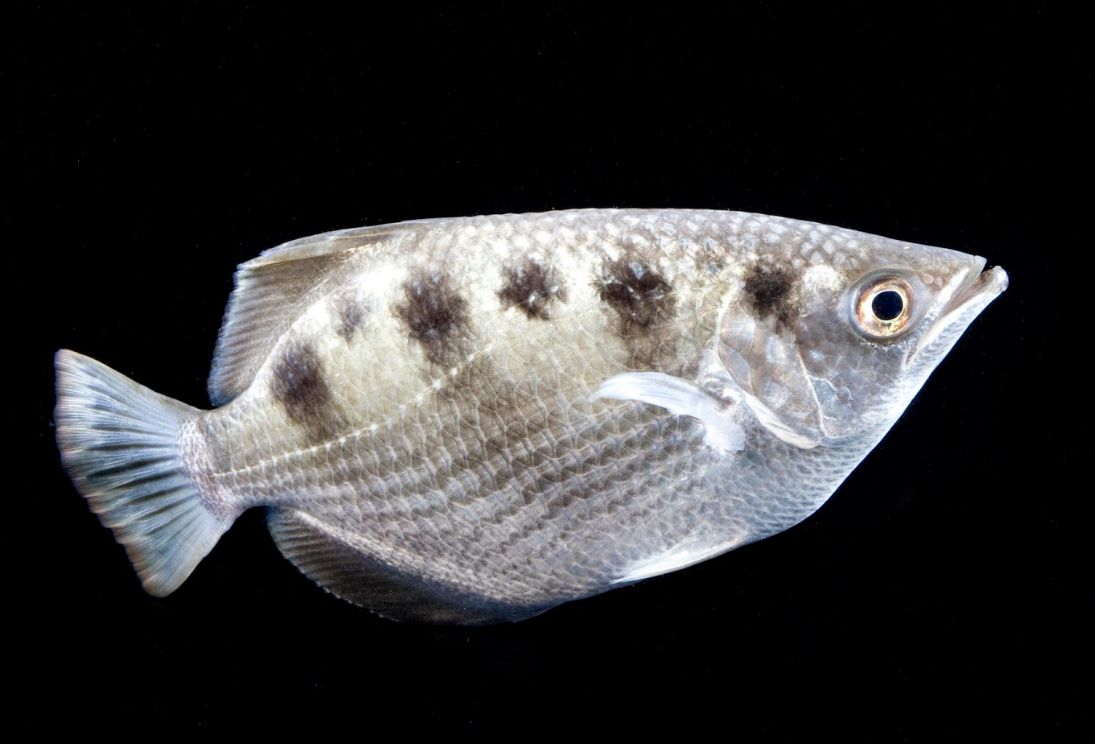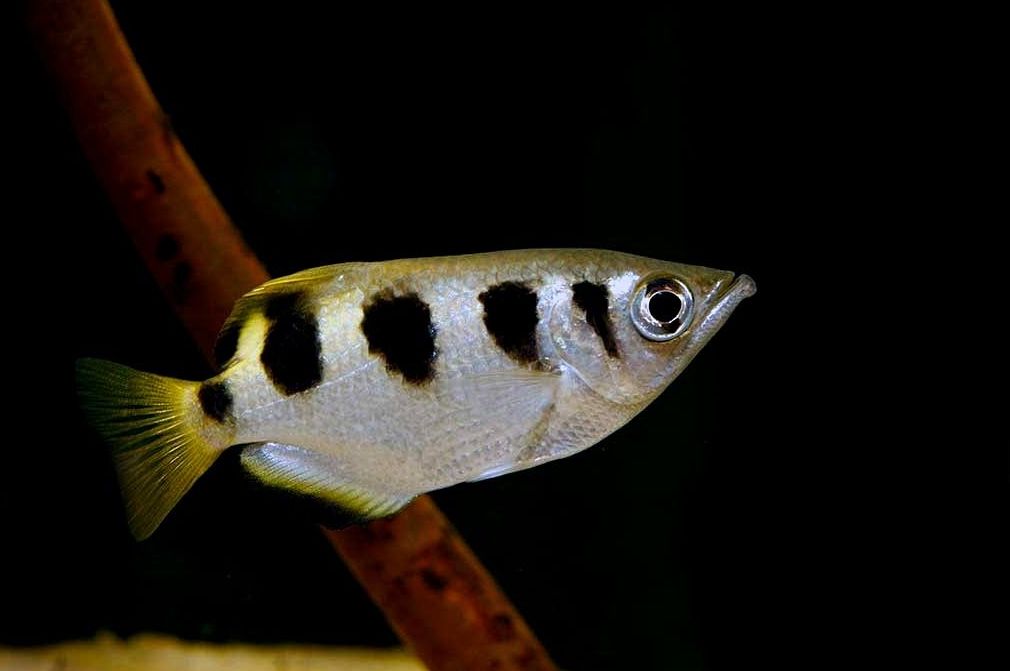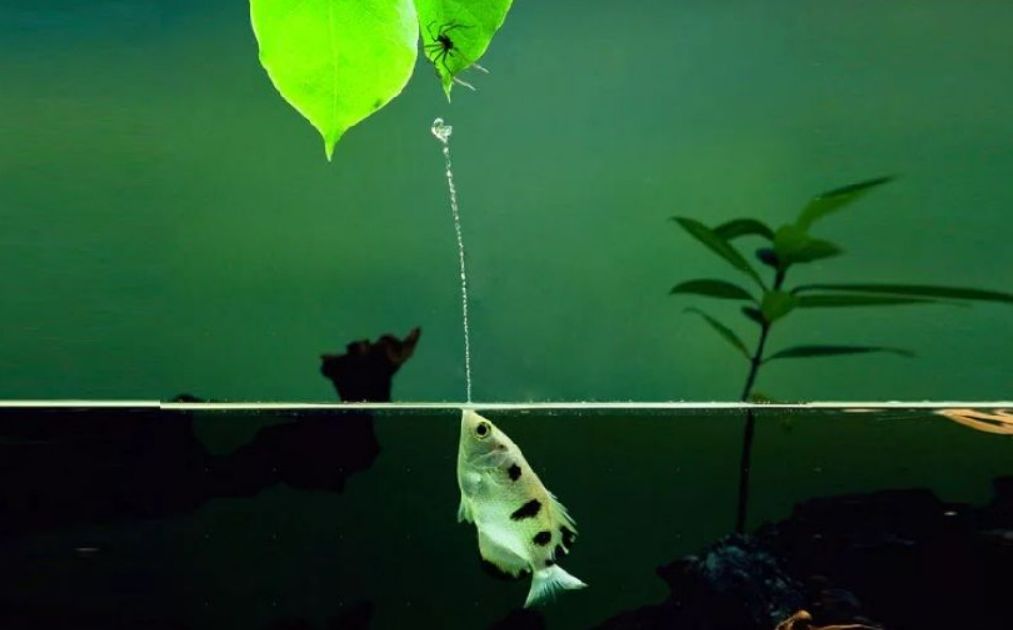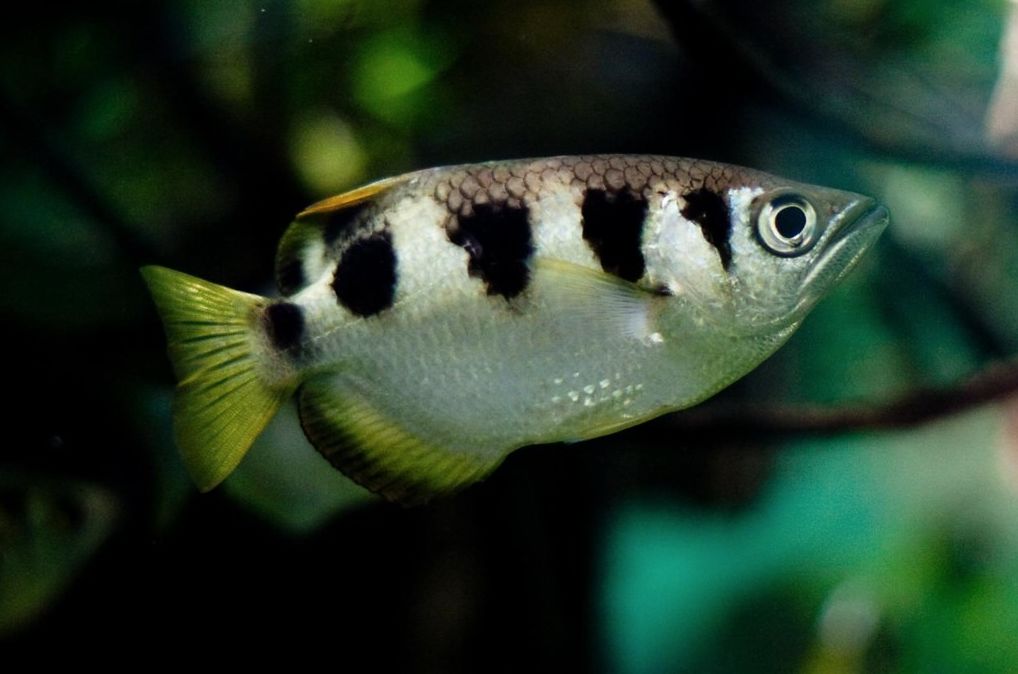Archer fish (lat. Toxotidae) belongs to ray-finned fishes of monotypic family Toxotidae, that in order to feed spray water in the air or on the ground to shoot down insects and then eat them. The droplets hit so hard that insects fall into water, where they are quickly eaten by the fish. It seems that the fish faultlessly knows where its prey falls and goes there fast before other fish gets it or it will be carried away by the water flow. Besides, archer fish similar to silver arowana can jump out of water to catch its prey, though not very high, just at its body length.

Contents
Habitat in the wild
Archer fish are primarily found in the brackish waters and estuaries of Southeast Asia. They can be found in countries such as India, Sri Lanka, Bangladesh, Myanmar, Thailand, Malaysia, Indonesia, and the Philippines.
The fish inhabits freshwater (mainly lentic waters), mangrove, it can get into open sea where its water is freshened by rivers. This fish prefers shadowed areas with vegetation hanging low above the water. Archer fish inhabit estuaries, mangrove swamps, lagoons, and other brackish water ecosystems. Brackish water is a mixture of freshwater and saltwater, typically found where rivers meet the ocean. These environments provide the ideal conditions for fish to thrive.
Archer fish are adapted to live in brackish water with varying salinity levels. They can tolerate a wide range of salinity, from nearly freshwater to slightly salty conditions. These fish are well-suited to environments where freshwater and saltwater mix, and they have developed physiological adaptations to regulate their internal salt balance.
Fish prefer habitats with dense vegetation, such as mangroves and freshwater streams. The vegetation provides shelter, nesting sites, and hunting opportunities. Mangroves are particularly important as they offer a complex network of roots and branches that archer fish can use as perches to spot prey.

Description
The genus Toxotes, part of the archerfish family (Toxotidae), includes a remarkable group of fish known for their precision hunting techniques. These fish are famous for their unique ability to shoot jets of water at insects above the surface, knocking them into the water where they can be eaten. Though each species has its own distinct range and subtle physical differences, they share this fascinating hunting behavior. Below are some notable species within the Toxotes genus:
- Toxotes chatareus (Archer Fish): Perhaps the most widely recognized member of the genus, the archer fish is native to Southeast Asia. It boasts a silver or greenish body and is highly skilled at hunting by shooting streams of water with impressive accuracy. This fish can often be seen near the water’s edge, targeting insects perched on leaves or branches.
- Toxotes jaculatrix (Banded Archerfish): This species, commonly found in the rivers and coastal areas of Southeast Asia, has distinct black bands across its silvery body. Native to regions like Indonesia, Thailand, and Malaysia, the banded archerfish displays the same water-spitting behavior as its relatives, making it an excellent predator in its environment.
- Toxotes lorentzi (Lorentz’s Archerfish): Endemic to Papua New Guinea, is named after the Lorentz River. It features a silver or greenish hue with dark vertical bands. Like other archerfish, this species hunts by targeting prey above the water, using its sharp eyesight and powerful water jets.
- Toxotes microlepis (Small-scale Archerfish): Native to the estuaries and rivers of Southeast Asia, including Indonesia and Thailand, this species has a distinctive silver body with smaller scales compared to its relatives. Despite its name, the small-scale archerfish excels in its hunting abilities, relying on its signature water-shooting technique to catch unsuspecting insects.
- Toxotes oligolepis (Big-scale Archerfish): Also found in the waters of Indonesia, particularly in Sumatra and Borneo, the big-scale archerfish is the smallest member of the genus. Its silvery body is marked by a bold black stripe running along its side, and it, too, employs the water-jet hunting strategy to capture prey just above the water’s surface.
Across the genus, these fish share certain physical traits: their bodies are laterally compressed, with slightly protruding lower jaws and large eyes. These adaptations allow them to spot insects perched on leaves or branches above the water, making them expert hunters in their unique niche.
Their behavior is a prime example of evolutionary adaptation, allowing fish to exploit food sources that other fish cannot reach. With their distinctive silvery appearance, bold markings, and remarkable water-shooting abilities, the Toxotes genus stands out as one of the most intriguing groups of freshwater fish.
Hunting
Species within the genus Toxotes, including the archerfish, share several fascinating traits, most notably their remarkable ability to shoot down prey with precise jets of water. These fish are exceptional marksmen, almost always hitting their targets, and can shoot water up to 1-2 meters depending on their size—the larger the fish, the farther it can shoot.
Archerfish develop this unique skill early on, becoming capable of spraying water when they are just 2.5 cm long. To execute their signature hunting technique, the fish positions itself just below the water’s surface, directly under its target. With a rapid movement of its gill covers, it forces water through a small groove on the roof of its mouth, squirting a well-aimed jet of water. The fish’s tongue and mouth shape help control the strength and direction of the shot, whether it’s a quick squirt or a series of droplets.
The amount of water squirted depends on the size of the prey, and the fish can repeat the action multiple times if necessary. Occasionally, if the prey is just out of reach, the archerfish may leap from the water to grab it, though this is less energy-efficient than shooting.
Archerfish are often found swimming in small schools, which adds a competitive edge to their hunting. When an insect or small prey falls into the water, they act quickly to snatch it up before others in the group can. Interestingly, while 90% of their diet consists of typical aquatic food, they resort to their impressive “shooting” ability when resources are scarce, targeting anything above the surface that looks like potential food.
This behavior makes archerfish one of the most intriguing predators in both brackish and freshwater environments, using their precision shooting to exploit food sources inaccessible to most other fish.
Size
It’s important to note that there are variations within the genus Toxotes, and different species may have slightly different size ranges. Some species, like Toxotes chatareus (archer fish), are known to reach larger sizes within the typical range, while others, like Toxotes oligolepis (Big scale archerfish), are smaller in comparison.
The adult archer fish species grow to be about 30 cm (12 in) long. In a tank fish size is a bit smaller 12–18 cm (5–7 in). However, the exact size can vary among species and individual fish. Some factors that may influence the size of archer fish include the species, age, and environmental conditions.
Additionally, female archer fish tend to be larger than males in some species. The size of archer fish can also be influenced by factors such as food availability, habitat conditions, and genetic factors.
Overall, when considering archer fish, it is common to find individuals ranging from 10 to 20 centimeters in length, but specific species and individual variations can lead to different sizes within that range.
Lifespan
The lifespan of archer fish can vary depending on various factors, including the species, environmental conditions, and individual health. Generally, archer fish have a lifespan ranging from 5 to 10 years in the wild.
However, it’s important to note that specific species within the genus Toxotes may have different lifespans. Factors such as habitat quality, availability of food sources, predation pressure, and overall stress levels can influence the longevity of individual archer fish.
In captivity, where they are provided with optimal conditions and care, archer fish can potentially live longer than their wild counterparts. With proper nutrition, appropriate tank size, and a suitable environment, archer fish in captivity may have extended lifespans compared to those in the wild.
| Characteristic | Description |
|---|---|
| Scientific Name | Toxotidae (family) |
| Size | Typically 10-20 centimeters (4-8 inches) in length |
| Body Shape | Sleek and elongated |
| Coloration | Silvery or greenish |
| Eye Placement | Eyes positioned on the top of the head |
| Hunting Technique | Shoots a powerful jet of water to knock down prey |
| Prey | Insects, spiders, and small invertebrates above the water |
| Habitat | Brackish waters, estuaries, mangrove swamps, and lagoons |
| Geographic Range | Southeast Asia (India, Sri Lanka, Indonesia, Philippines, etc.) |
| Water Preference | Brackish water, but can adapt to freshwater in some species |
| Social Behavior | Often found in small groups; exhibit cooperative hunting |
| Communication | Visual displays and specific body movements |
| Adaptations | Precise water-jet aiming, adjustments for distance and refraction |
| Reproduction | External fertilization, eggs released into water |
| Lifespan | Varies by species; typically 5-10 years |
| Temperature | 25-30 degrees Celsius (77-86 degrees Fahrenheit) |
| pH Range | 6.5-8.0 (tolerant of slightly acidic to slightly alkaline conditions) |
| Water Hardness | Moderate to slightly hard water (around 8-12 dH) |
| Conservation Status | Varies by species; some are of least concern, others data deficient |

Difficulties in keeping
Archerfish are best suited for experienced aquarists due to their unique care requirements. One of the main challenges is feeding them. In their natural environment, archerfish instinctively hunt for food above the water’s surface, so they may initially ignore traditional tank food. However, with time and patience, they can adapt to being fed like other aquarium fish.
Adult archerfish also require brackish water with stable parameters, which can be difficult to maintain. They prefer live prey, and their natural hunting behavior makes them more inclined to catch food themselves. To accommodate this, it’s essential to provide a tank with a low water level and enough space above it, allowing the fish to “shoot” at prey or even leap out of the water.
For this reason, many owners design their archerfish tanks as paludariums—a type of aquarium that mimics both aquatic and terrestrial environments. In a paludarium, archerfish thrive in a setting that closely resembles their natural habitat. The setup not only makes feeding easier (by placing insects on plants above the water) but also enhances the fish’s natural behavior, creating a more appealing and enriching environment for both the fish and the viewer.
Care and keeping in a tank
Tank size
Recommended tank capacity starts from 250 liters (55 gallons) for several adult fish species, because this is quite large fish that prefers a company of its kind. To create optimal tank conditions it is advisable to keep the water level about several dozens of centimeters lower than tank top. This will allow the fish to ‘shoot’ its prey.
Tank decor
It is acceptable to keep the fish both in aquarium and paludarium. The latter is more preferable in terms of natural way of the fish feeding. In case when you have a paludarium, create some vegetation hanging over the tank water and put future prey of archer fish there.
The tank lid should be safe (electrics may get wet) and always closed, since the fish can jump out of water.
The water flow in a tank should be of minimal power. The lighting can be bright or moderate depending on the tank plants you put. You can put any kind of tank bottom substrate, since fish swims close to water surface and it’s not crucial for it. Lots of snags can be put into the tank as decorations.
Water parameters
Water parameters: 21–27 °C (70–81 °F), pH 6.0-7.5, 5-20 dGH. Tank water should be brackish with salt concentration up to 15 grams per 1 liter of water. The fish juveniles successfully live in fresh water, though there are cases when adult fish species also dwell in fresh water for quite a long time.

Diet
Archerfish have a fascinating carnivorous diet, primarily consisting of insects and small invertebrates. Their most iconic behavior is their unique hunting method—shooting down prey from above the water’s surface using precise jets of water. In the wild, archerfish feed on flies, spiders, mosquitoes, and other insects perched on plants or hovering near the water. They also consume juvenile fish, small invertebrates, and larvae.
In a home aquarium, feeding archerfish can be a challenge, especially when transitioning them to a diet that includes sinking or artificial food. However, many aquarists prefer to feed them live prey to observe their natural hunting behavior—one of the primary reasons people are drawn to keeping these intriguing fish.
Feeding in the Aquarium: Archerfish are most engaging to watch when they hunt naturally, which requires a bit of creativity. Aquarists often simulate their wild feeding behavior by placing crickets, flies, or other insects just above the water’s surface. The insects should be positioned high enough that the fish cannot simply leap out of the water to grab them—forcing them to use their signature water jet technique.
This feeding method is easier in a paludarium, where vegetation and structures above the water can create a more natural environment. However, if a paludarium isn’t available, there are simpler alternatives. One common technique is to use a long rod or stick, placing an insect on it and holding it above the water surface. Even if the fish misses its target, the insect will eventually fall into the water, ensuring the archerfish can still eat it.
Once archerfish are accustomed to aquarium life, they can adapt to eating underwater or from the surface, so feeding becomes less difficult over time.
Archerfish Diet Overview:
- Insects: Flies, beetles, mosquitoes, and other small flying insects make up a large part of their diet. Archerfish are precise hunters with excellent aim, shooting down prey that is perched on vegetation or flying close to the water.
- Spiders: Occasionally, spiders within reach of the fish may also become prey, particularly those hanging over the water surface.
- Small invertebrates: Besides insects and spiders, archerfish consume small invertebrates such as crustaceans and aquatic insects that live in brackish or freshwater environments. These prey items are typically found within the same ecosystems archerfish inhabit.
While training archerfish to eat prepared foods can take some time, the joy of watching them hunt naturally is what makes these fish so appealing to experienced aquarists. Their accuracy and unique behavior make them one of the most captivating species to observe in the aquarium.
Tank mates
In general this is a peaceful and calm fish, which by the way can eat its smaller sized tank mates. Due to special conditions of the archer fish keeping, the range of compatible fish species is quite limited. Fishes capable to stand high water salinity will be a good choice in this case. But, usually, they are small sized and fish may treat them as food.
When selecting tank mates for archer fish, it is important to consider their specific needs and behaviors. Here’s a table suggesting some potential tank mates that can coexist with archer fish:
| Potential Tank Mates | Compatibility Description |
|---|---|
| Banded Scats | Peaceful, brackish water fish that can coexist with archer fish. They have a similar water preference and are known to inhabit the same habitats in the wild. |
| Gobies | Many goby species can thrive in brackish water and are generally peaceful. They are small and won’t compete for food with the archer fish. However, ensure that the specific goby species selected is compatible with the archer fish’s needs. |
| Monos | Monos are schooling fish found in brackish water and have similar water parameter requirements as archer fish. They can be compatible tank mates if provided with appropriate tank size and suitable social dynamics. |
| Mollies | Brackish water mollies are hardy fish that can tolerate similar water conditions as archer fish. They are generally peaceful and can coexist with archer fish if provided with adequate space and hiding spots. |
| Knight Gobies | Knight gobies are brackish water fish known for their interesting behavior and compatibility with archer fish. They have a similar tolerance for salinity and can coexist if given enough space and hiding places. |
| Columbian Shark Catfish | Columbian shark catfish, also known as catfish shark or blackfin shark, can be compatible with archer fish in larger aquariums. They prefer brackish water and can coexist if there is enough space and hiding spots for all tank inhabitants. |
| Mudskippers | Mudskippers are unique brackish water fish that can live in partially submerged and terrestrial environments. While they have different behavior than archer fish, they can coexist in larger tanks with appropriate setup and conditions. |
Archer fish are not known for aggressive behavior toward other fish species. They are generally compatible with a variety of tank mates, especially those that share similar water conditions and temperaments.
In general, archer fish tend to be relatively peaceful toward conspecifics (members of the same species). They often form small groups or schools in the wild and cooperate during hunting. However, territorial disputes and aggression may occur between individuals if they are overcrowded or if there is limited space for establishing territories within the tank. Intraspecies relations of fish species are based on domination of a stronger fish species. It is desirable to keep a group of at least 4-5 fish species. If there are less of them, the fish tends to demonstrate aggression.
Gender differences: male vs female
Gender dimorphism isn’t pronounced. However, there are a few key traits and behavioral differences that can help identify the gender of archerfish, though these may become more apparent as the fish mature:
- Females are generally larger and more robust than males, particularly when they reach full maturity. In some species, females may have a rounder body shape, especially during breeding periods when they are carrying eggs.
- Males tend to be slightly smaller and slimmer in comparison, though the difference in size may not be highly pronounced.
- During the breeding season, female archerfish may have a noticeably rounder abdomen as they carry eggs. This is often the easiest way to distinguish females, though it’s not a year-round indicator.
- Males typically retain a more streamlined, elongated shape throughout their life.
- Behavioral differences become clearer during spawning. Males may become more aggressive or exhibit courtship behaviors such as chasing females or defending specific areas of the tank.
- In some species, males take a more active role in fertilizing eggs and may show more territorial tendencies during the breeding season.
- In some fish species, males develop slightly longer or more pointed fins, though this is not a definitive characteristic in archerfish. Observing their fins closely over time might reveal subtle differences.
- Archerfish do not exhibit drastic color changes during breeding, unlike some other fish. However, there may be slight shifts in brightness or intensity of their silver coloration in both males and females when they are ready to breed.
Breeding
Breeding archerfish in captivity is a challenge even for experienced aquarists. In the wild, these fish breed in brackish environments with fluctuating salinity and large open spaces, conditions that are difficult to replicate in an aquarium setting. While breeding archerfish is rare in home tanks, it is possible with the right conditions and careful attention to their needs. A large, spacious tank is essential, as these fish naturally breed in open waters, and overcrowding can stress them and prevent successful spawning.